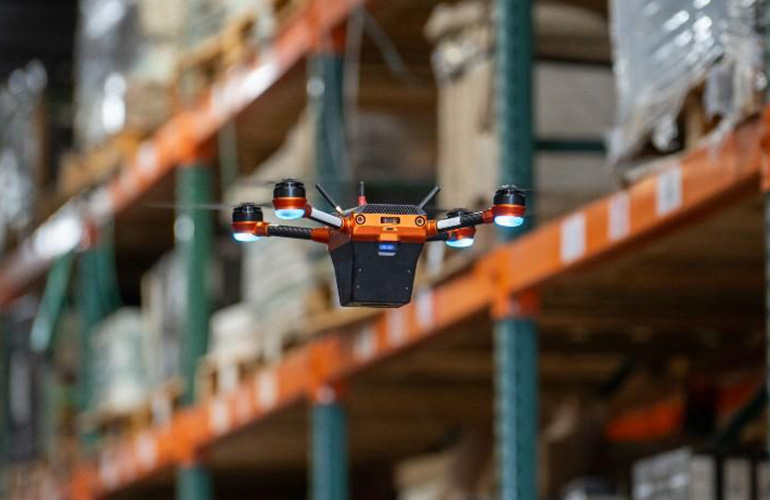Corvus Robotics Inc. has closed an $18 million Series A round and seed funding led by S2G Ventures and Spero Ventures. The Mountain View, Calif.-based company has been engineering and validating its inventory drone system since it was founded in 2017.
Until now, Corvus has been relatively quiet with marketing and sales. With the funding, the company has a new war chest and is hiring new marketing, sales, and support staffers to begin expanding its customer base.
Co-founder and CEO Jackie Wu told The Robot Report that “something like a quarter of the Fortune 500 is in our pipeline” — good news for a company ready to spread its wings, or rotor blades, and fly.
Corvus drones operate without infrastructure modifications
Most warehouses feature endless straight aisles, stacked from floor to ceiling with inventory. Learn how to fly autonomously and move up and down one aisle, and you can repeat that operation throughout the entire warehouse.
However, due to the uniformity of warehouse aisles, it is easy for autonomous vehicles like autonomous mobile robots (AMRs) and aerial drones to get lost, as any aisle looks like every other aisle. When an autonomous system gets lost, it must ask an operator for help.
Most AMR and drone inventory providers have simplified the localization and lost robot conundrum by fitting the warehouse with fiducials or AprilTags that enable their machines to remain localized throughout a facility. All the robot has to do is locate to the closest tag, and it knows where it is.
Corvus designs and builds its drones in the U.S. The company has engineered custom localization and navigation algorithms that map an entire facility without requiring facility modifications such as placing additional fiducial markers.
“Corvus Robotics fits our mission to invest in companies that truly transform the way business is conducted,” said Marc Tarpenning, co-founder of Tesla and partner at Spero Ventures. “Other than a landing pad, its drone-powered system requires no infrastructure, is quick and easy to deploy, and cost-effective to manage. It literally merges with the existing warehouse environment.”
Austin Feagins, senior director of solutions at Staci Americas, noted that “being able to run inventory checks 24/7 without operator assistance has been a game changer.”
Drones continuously scan the warehouse
The bane of warehouse managers is lost or misplaced inventory. The speed of e-commerce is accelerating, and losing things in a facility affects both top-line revenue and bottom-line profit.
Drone-based inventory systems like Corvus can not only track the location of items, but they can also be deployed to spot-check recent work, verifying that items have been moved and placed as anticipated.
Corvus drones are equipped with high-end barcode scanners that provide precise information about inventory data. These are the same tools that have been used by human associates for decades.
In addition to reading barcode data, the drone can also use computer vision to locate pallets, and count items on pallets. All of this information is reconciled with the warehouse management system (WMS).
According to Wu, Corvus qualifies customers to ensure that they already have an existing WMS, because inventory counting is useless without somewhere to sync the data to engage with the order and shipping workflow.
The role of the drones is to maintain the truth and traceability of the order put-away/replenishment and order-picking workflow. Supervisors can initiate spot checks and request the drones to validate item placement at the end of a shift or anytime throughout the workday.

Corvus One deploys fully autonomous drones, providing warehouses and production plants with efficient inventory management. | Credit: Corvus Robotics
Inventory system works with very narrow aisles
For distribution centers with high-bay storage, drones can access areas that are difficult for traditional equipment like scissor lifts. This expanded reach allows for more efficient inventory management and retrieval, even in tight spaces.
Corvus drones can navigate aisles as narrow as 50 in. (127 cm). The ability to fly in very narrow aisles (VNA) increases the potential applications of drones, said the company.
Drones are best suited for environments where narrower aisles make operations of pivot trucks or other vehicles less feasible. However, businesses with even denser automated storage and retrieval systems (ASRS) may not need drones.
Corvus One updated for ‘lights-out’ operations
Corvus has also updated its Corvus One system to enable its drone to fly in an automated distribution center and complete inventory scans. This means that the drones can be tasked to fly overnight, while the facility is empty, or to fly in areas where there is no human activity and where lighting might be turned off to save money. Each drone has its own light, to brighten the scene for the onboard scanners and cameras.
“The lights-out capability in the Corvus One system allows our inventory teams to correct discrepancies off-shift and pre-shift before production starts each day, limiting fulfillment delays and production impacts,” said Austin Feagins of Staci Americas.
“The Corvus One system is a vital component of end-to-end inventory visibility and optimization,” Wu added. “We’re growing extremely quickly, and our recent funding round will be used to help Corvus meet rapidly growing customer adoption while continuing to build products with capabilities nowhere else in the world ever has had.”




